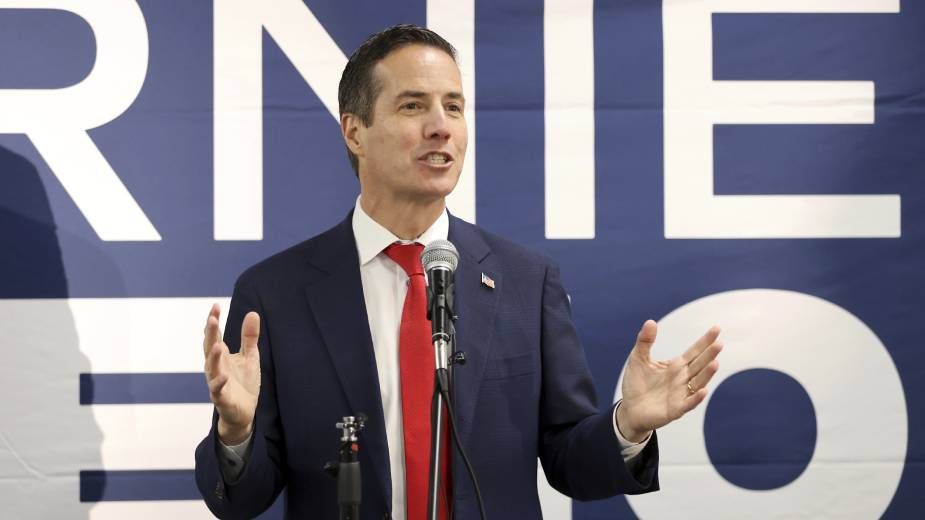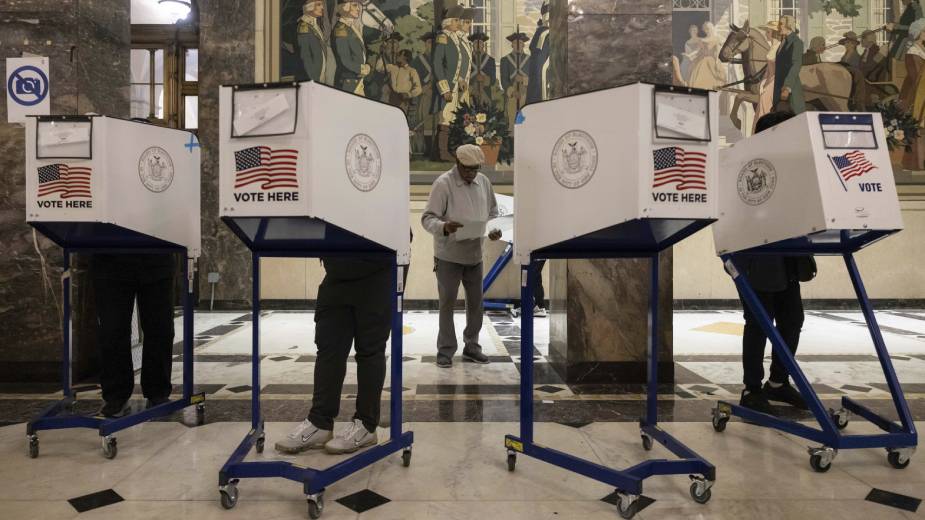Marijuana Legalization Bus and Mascot Stop at YSU
YOUNGSTOWN, Ohio – Advocates of state Issue 3, the initiative to legalize marijuana in Ohio, stopped on the edge of the Youngstown State University campus Monday afternoon to raise awareness by meeting reporters and students.
The reporters knew the Green Rush Bus – actually a Ford F-350 pickup truck with a topper – was coming and were prepared for the one-hour stop, one of 150 across Ohio between Aug. 17 and late October.
The students? Well, not so much. Most of the few who stopped by took selfies with Buddie, the mascot accompanying Faith Oltman, a spokeswoman for ResponsibleOhio.
And yes, Buddie, whose head resembles a green, oversized marijuana bud, is a pun, Oltman admitted after a coy, “It could be.”
She paused before clarifying, “It’s a good one,” as she waited for other reporters to show up and for Buddie to emerge from the back of the F-350.
(Buddie allowed Oltman to do all the talking.)
Oltman had no new information beyond what the backers of ResponsibleOhio have said. Her goal is to make more voters aware of Issue 3 and the benefits of amending the state constitution, she said, so that it’s legal to grow and consume marijuana for medical and personal use.
The backers of Responsible Ohio tout Issue 3 as allowing the birth of a “multibillion dollar industry that will bring $9,181,453 to Mahoning County and its townships and municipalities in taxes per year by the time the market stabilizes in 2020.” This assumes Issue 3 passes and Issue 2 fails.
On the next stop, Warren, Oltman put forth identical language but different figures for Trumbull County. “Trumbull County and its townships and municipalities” would share “$8,109,058 in new tax revenue per year by the time the market stabilizes in 2020.”
How did they arrive at theses figures? “County revenue projections were prepared by campaign staff using the best available data and methods,” Oltman emailed afterward. “Burke, Rosen & Associates, a third-party economics firm in Cleveland, validated the model’s methodology.”
She would not or could not elaborate at the meeting with reporters or in her email how campaign staff prepared the county or state revenue projections, let alone with such precision.
Matt Amoroso, senior economist at Burke Rosen, confirmed that his firm, founded in 1970 and which consists of five economists, validated the methodology and expects to be asked to replicate the data. He wasn’t sure if the firm has been paid or will be paid for its validation.
ResponsibleOhio asserts that legalizing marijuana in Ohio would create “around 10,000 well-paying jobs” by giving people in the marijuana trade the right “to own and operate [up to 1,159] retail stores and medical dispensaries, [25] testing labs and [10] product manufacturing facilities,” the last more familiarly known as farms.
In the statement of opposition the Fraternal Order of Police issued Monday, the group noted that the 1,159 stores that would be authorized under Issue 3 is “more than the number of Starbucks or McDonald’s locations and nearly three times the number of state liquor stores in Ohio.”
The amendment, the FOP continued, “would not restrict felons from owning [the marijuana stores], which may be located close to schools, daycare [centers] churches and other locations constructed [since] Jan. 1, 2015.”
The Green Party of Mahoning County issued a statement of opposition yesterday, “Business and Marijuana,” saying, “The Green Parties State of Ohio and Counties of Mahoning and Trumbull oppose Issue 3 … and encourage Ohio voters to vote down this plan in November. … The ResponsibleOhio plan does not protect the interests of small farmers, consumers, local control or free trade.”
It does support Issue 2, the Green Party statement said, because the drafters of that initiative seek to “bar monopoly interests from becoming part of Ohio’s constitution.”
On the other hand, the Green Party does “support the legalization of marijuana for medical and recreational use in concept,” but not as ResponsibleOhio would do. Jim Villani, editor of Pig Iron Press, 26 N. Phelps St., put the address of his shop but not his name on the Green Party statement.
Asked why the backers of Issue 3 want Ohio to allow 10 marijuana farms the first four years instead of following the model in Colorado, Oltman said that state “is not well regulated” and has had trouble controlling the “unlimited number of licensures [licensed shops]” and some growers’ use of pesticides that she said made some users sick. “It was the Denver police that arrested [the grower], not the state of Colorado,” she said.
Oltman insisted that allowing the creation of 10 marijuana farms the first four years would allow competition – she took issue with reporters calling such an arrangement a monopoly, oligopoly or cartel – but couldn’t say whether they would compete on price or quality or any basis.
The airline industry remains a highly regulated oligopoly whose members try to legally signal other members of price increases and impose various fees they want to impose so they’ll stick. A reporter suggested to Oltman that this model could well be a model for the 10 farms to follow.
Oltman denied that the airlines industry model, or any other industry model, would apply to growing marijuana in Ohio.
Under Issue 3, a commission of eight persons appointed by the governor would oversee the growing, sales and consumption of marijuana, Oltman said, but couldn’t say whether or how much they might be compensated or the extent of their authority.
Those Ohioans over 21 who don’t want to patronize a marijuana store can grow up to four plants in a secure place in their homes, that is, out of the reach of minors, Oltman pointed out.
The 10 farms would be required to send samples of their plants to one of five “testing facilities” set up to monitor quality. The sites likely would be at or connected to universities but YSU would not be one of them, she told reporters.
As one aspect of the effort keep marijuana out of the hands of minors, the state would conduct sting operations just as it does with merchants who sell tobacco and alcohol, Oltman said. She expects undercover agents would visit marijuana outlets just as they visit bars and tobacco outlets to ensure bartenders and clerks ask for and inspect the identification purchasers offer.
Pictured: Michael McGovern, “Buddie,” and Faith Oltman of Responsible Ohio make a stop at YSU.
Copyright 2024 The Business Journal, Youngstown, Ohio.



